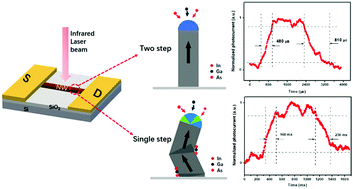Enhanced performance of near-infrared photodetectors based on InGaAs nanowires enabled by a two-step growth method†
Abstract
Because of the tunable bandgap, high carrier mobility and strong interaction with light, ternary III–V nanowires (NWs) have been demonstrated with tremendous potential for advanced electronics and optoelectronics. However, their further performance enhancement and practical implementation are still a challenge in the presence of kinked morphology and surface coating of the nanowires. Here, we report the development of high-performance near-infrared photodetectors based on high-quality InGaAs nanowires enabled by the two-step chemical vapor deposition method. Importantly, the optimized In0.51Ga0.49As NW devices exhibit excellent photodetector performance at room temperature, with a responsivity of 7300 A W−1, a specific detectivity of 4.2 × 1010 Jones and an external quantum efficiency of 5.84 × 106% under 1550 nm irradiation. The rise and decay time constants are as efficient as 480 μs and 810 μs, respectively, constituting a record high performance among all arsenide-based nanowire photodetectors. Large-scale NW parallel-arrayed devices are also fabricated to illustrate their promising potential for next-generation ultrafast high-responsivity near-infrared photodetectors.



 Please wait while we load your content...
Please wait while we load your content...